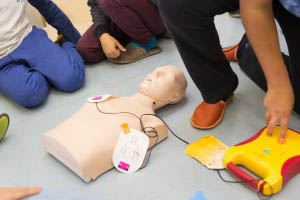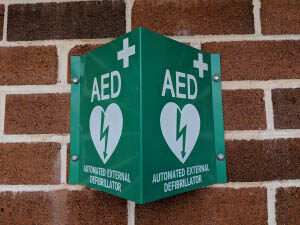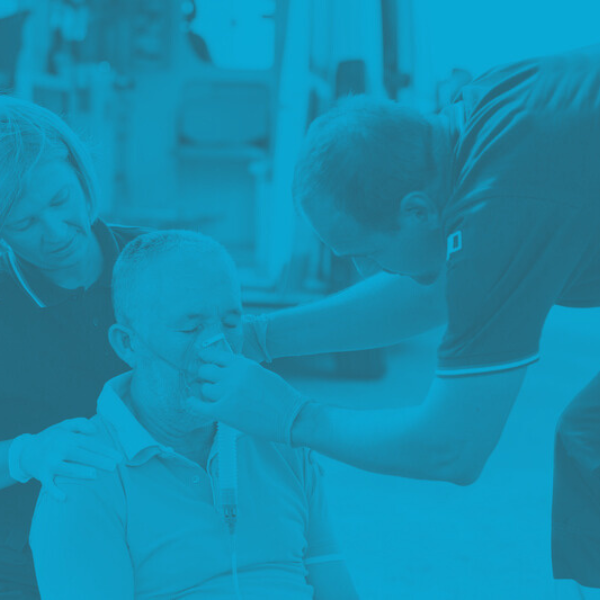How AMC Can Help You With Your AED Training Program
How AMC Can Help You With Your AED Training Program

by Greta Kviklyte
Life Saver, AMC
Co-authored by Kim Murray, RN, M.S.
posted on Apr 5, 2019, at 10:18 pm
Implementing an automated external defibrillator (AED) training program empowers staff, passersby and trained professionals to save lives outside a healthcare facility. Depending on your industry, deploying such a program may reduce liability, provide peace of mind for your consumers and prevent tragedies. Furthermore, an AED training program demonstrates responsible business ownership, increasing brand value. Implementing such a program is more complex than simply purchasing a device. However, it is the most important tool to expand your business’s capability to provide life-saving support for those who suffer out-of-hospital cardiac arrest (OHCA).
We offer Online ACLS, PALS and BLS Certification and Renewal
During implementation, care must be taken to find the right defibrillator for your business. Owners must review local laws, proactively manage the risks of making a device accessible, ensure employees have the right training and more. The risks will always be worth the trouble, and in fact, those that follow these steps can ensure program success and save lives too.

What Industries Benefit from an AED Training Program?
All industries will benefit from the implementation of an AED training program. However, some industries are more likely to utilize the device due to an increased risk of suffering OHCA. BizJournals reports that these industries and businesses include the following:
- Industries where people work closely together. These businesses include offices and factories, where heavy and industrial machinery can result in tragedies in the workforce. If an incident does occur, having a device nearby can be the difference between life and death.
- Transportation providers. Businesses in this industry have a duty to ensure the safety of their consumers, and may also be among the first to recognize cardiac stress in passersby.
Construction companies. Workers for companies that manage outdoor worksites are subject to the risk of a lightning strike or other injuries, such as those caused by animals. As a result, implementing a program to keep AED devices close to workers, such as placement in vehicles, can lower mortality risks. - Healthcare clubs, fitness units, gymnasiums and cafeterias. These businesses should also have AED training programs, as their customers may have undiagnosed chronic illnesses. The Mayo Clinic reports that the risk of a cardiac event is higher among this population group.
- Businesses in locations where rapid access to emergency medical services isn’t possible. These job sites include remote construction projects, maritime vessels, energy pipelines and offshore drilling rigs.
- Educational institutions. These organizations may be required by state or local regulations to implement an AED training program. However, private institutions may not be subject to the same regulations governing the use of and access to funding sources.
- Service-oriented businesses. An AED training program in businesses like shopping malls, retail centers and restaurants and other service-oriented businesses can save lives, as OHCA is more common in areas where people congregate.
Key Steps to Implementing a Successful AED Training Program
Implementing a successful AED training program is a complex, detailed process. Businesses that are considering such a program should follow the following steps to ensure it succeeds.
1. Determine whether AED training is necessary
This is the most important step in installing a defibrillator program in your organization. Businesses may opt to implement a program for a variety of reasons, but the underlying desire to save lives must remain the highest priority. The biggest issue that companies face is the decision of whether a program is necessary.
While a defibrillator can save lives, it isn’t always best practice to install one in each building, site or other location. Depending on the size of your business and profit margins, such a strategy could easily rack up thousands of dollars in costs, or even more than $100,000. Furthermore, these costs don’t include training and program development costs. As a result, it’s essential for businesses to take a comprehensive look at whether a defibrillator is truly necessary and how it will improve the experiences of employees and consumers.
Ultimately, a defibrillator is a great way to reduce the risk of mortality from a cardiac event. However, no business should implement an AED training program simply for the appearance of safety. Such programs have detailed needs and requirements that are much more involved than you would expect of a status symbol. If a program is right for your organization, the next step will help you begin the real work of installation.
2. Work with a physician or other experienced healthcare professional to develop an implementation program and timeline
Depending on your location, physician supervision and guidance is necessary to implement an AED training program. Some states do allow for non-physician support in developing a program, but the burden of responsibility for ensuring proper adherence to local standards and statutes falls to each business owner. Therefore, it’s essential to work with an experienced healthcare professional who understands the complexities, risks and best practices in implementing and deploying an AED training program. Furthermore, working with a physician ensures your organization takes these additional steps during implementation and throughout the life of your program:
- Document everything. Proper documentation is essential to reducing your liability for injuries or other unintentional harm caused by defibrillator use. In addition, documentation is necessary to maintain compliance with applicable laws and ensure all likely users, such as employees, understand how to use the device properly.
- Maintain Your Devices. Developing a written plan for maintaining your defibrillators is another vital step in the installation of such programs. Determine when you should replace batteries, pads or wires, and create a way of validating such replacements. For instance, keeping a notepad within a device’s case is a great way to track replacement actions.
- Use Proper Signage. When a program is installed, it lacks value if passersby don’t know where it’s located. Even in secure facilities, employees who haven’t yet completed AED training may need it. As a result, it’s important to specify signage rules for implementation within the program materials and ensure all potential users know where to access the device.
3. Decide on the type of device to purchase
Many types of AED devices are currently available for purchase. Certain defibrillators may resist drops, dirt, water or other elements, while others are designed to withstand falls or other potential risks. For example, implementing an AED in a location where workers use heavy machinery or other equipment used may be subject to multiple conditions during regular operations, as well as during an emergency. Furthermore, the best type of device to purchase may depend on location. For example, a fully-automated system automatically delivers a shock, while semi-automatic systems require user intervention to deliver a shock.
4. Choose a location for devices, and ensure they’re kept away from children
Implementing an AED training program can lead to a higher risk of injury if you use it improperly. This includes accessing the device outside an emergency, or allowing children and passersby to “play” with the device. However, the legal liability for implementation of a device is minimal, according to Markel Insurance. The key to minimizing this liability lies in ensuring a comprehensive program that adheres to all applicable standards, best practices and concerns that may present a risk to those in your facilities.
5. Register your location for emergencies
In addition to reviewing local laws and statutes governing the implementation of an AED training program, it’s important to notify the local emergency medical services (EMS) department of an AED implementation. Even in areas where such notification isn’t mandated by law, it can help busy departments ensure communities have adequate access to life-saving measures. Furthermore, each person who recognizes your location as a place to obtain a defibrillator for emergencies is more empowered and able to help others when emergencies occur.
6. Conduct User Training for All Possible Parties, Especially Employees
Proper user training is a crucial aspect of installation. Most automated devices don’t require much training to use, but knowing how in advance will save lives. Think about it this way; no one has time to read an instruction manual when an emergency arises. Therefore, companies should pay for employees to attend an AED training course or conduct it themselves. Training may also be a legal requirement in your area. In addition, you should maintain records of certification for use and review them during program audits and device maintenance.
7. Train staff to handle other emergencies
A staff member is likely to jump into action when an emergency arises if they’ve been trained. In addition to preparing for a cardiac event, businesses should train their staff on how to respond to other emergencies. In today’s world, these emergencies may range from shootings to wildfires, as well as extreme weather events. Ready.Gov reports that staff should know how to respond to each potential issue, including evacuation routes, safe zones, lockdown practices, and emergency supplies.
8. Expand service capabilities with CPR and First Aid
Another effective way to improve the ability of staff members to respond to emergencies is to provide them with training that goes beyond just using a defibrillator. For example, training for cardiopulmonary resuscitation (CPR) and first aid also shows employees how to provide immediate care to people with additional injuries, up to and including heart problems. It’s also important to create a first aid kit during this phase or consider purchasing one. Ultimately, such a kit expands your team’s service capabilities.
9. Integrate defibrillator program materials with disaster and emergency preparedness and recovery plans
Phys.Org explains that the U.S. has endured more multi-billion dollar disasters in recent years than any other time in history. Some of these costs are attributable to the increased value of property, but the biggest issue remains; disaster prevalence appears to be increasing at an alarming rate. Even areas with a lower risk of severe weather and natural or manmade disasters are starting to feel the effects. At the same time, the frequency of cascading disasters—those that only grow in severity or contribute to subsequent disasters—is also increasing. Unfortunately, people with underlying medical illnesses may have a higher risk of OHCA when these events occur. Thus, integrating your AED training program with existing disaster preparedness and recovery plans should be a key step in implementing these programs. This approach ensures your team members and customers understand your willingness to help them during adverse events.
10. Use the program to add value for your customers
Your public relations (PR) strategy for installing a defibrillator is the final step in implementing an AED training program. After all, the best program in the world will be wasted if no one knows about it. Implementing a program also adds brand value to your organization by putting the fears of staff members and consumers at ease when doing business with you and your team. Your PR strategy for a defibrillator should also include soliciting feedback from community members and consumers. This feedback may include their feelings about AED training implementation, questions, ways to learn more about its use and its impact on current activities. Ultimately, the program is a great way to get more customers in the door and interested in what you do.
Get Started With Your Program by Learning How to Use the Device Properly
 A defibrillator program is only one aspect of preparing your business for an emergency. However, before you decide to install a program and begin the process of ensuring its success, you should get ACLS certification or recertification for yourself. You’ll see how easily and quickly you can use a defibrillator and how it can mean the difference between life and death.
A defibrillator program is only one aspect of preparing your business for an emergency. However, before you decide to install a program and begin the process of ensuring its success, you should get ACLS certification or recertification for yourself. You’ll see how easily and quickly you can use a defibrillator and how it can mean the difference between life and death.
If you’ve already purchased a defibrillator, it’s not too late to review the steps for using it and ensure you haven’t overlooked anything. If you’ve previously implemented an AED training program and have any tips to add, share them on social media now.
Frequently Asked Questions About AEDs
Why is my AED making noises?
AEDs periodically perform self-test, usually at least once a week. All models should test the battery level and perform internal diagnostics, but some also check the condition of the electrode pads and gel. If a unit fails any of these tests, it will emit a beeping or chirping sound. Turning the unit on should produce an audible explanation of the problem that requires attention.
Can an AED be used on a child?
Yes, most AEDs are able to administer a lower level of electricity for use on smaller patients, such as children. Some models provide separate pads for these patients, while others allow you to adjust the shock level with a physical control like a key or switch. Most manufacturers set the threshold for lower output at 65 pounds.



